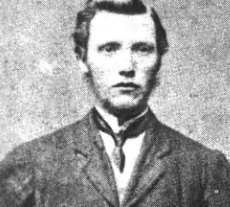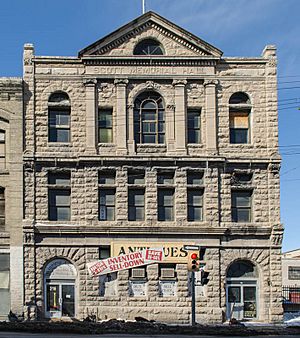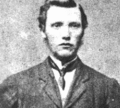Thomas Scott (Orangeman) facts for kids
Quick facts for kids
Thomas Scott
|
|
|---|---|
 |
|
| Born | 1 January 1842 Clandeboye, County Down, Ireland
|
| Died | 4 March 1870 (aged 28) Upper Fort Garry, Red River Colony, Rupert's Land
|
| Cause of death | Execution by firing squad |
| Occupation | Surveyor for Dawson Road Project, Soldier in the Hasting's Battalion of Rifles |
Thomas Scott (born January 1, 1842 – died March 4, 1870) was an Irish Protestant who moved to Canada in 1863. He worked on a big road project called the "Dawson Road". Later, he went to Winnipeg and joined a group called the Canadian Party.
Scott became involved in the politics of the Red River Settlement. This led to him being captured at Fort Garry and held with others. On March 4, 1870, Scott was executed by the temporary government of the Red River Settlement, which was led by Louis Riel.
Scott's execution caused a lot of anger. It led to the Wolseley Expedition, a military force sent by Prime Minister John A. Macdonald. This force was meant to deal with Riel and the Métis people at the Red River Settlement. Scott's death shows a time of big disagreements between settlers and the Métis in Canadian history. It also led to Louis Riel being forced to leave the area and, later, to Riel's own execution in 1885 for a serious crime against the government.
Contents
Thomas Scott's Early Life
Not much is known about Thomas Scott's early years. He was born in 1842 in the Clandeboye area of County Down, which is now Northern Ireland. He grew up in the Presbyterian faith and was active in the Orange Order. In 1863, Scott moved to Ontario, Canada.
When he arrived at Red River, he worked as a laborer on the "Dawson Road" project. This road was being built to connect the Red River area with Lake Superior. In 1869, Scott took part in a workers' strike. After this, he was fired and faced charges for a fight. Scott then moved to Winnipeg. There, he met John Christian Schultz and became a supporter of the Canadian Party. Scott wanted the Red River Settlement to become part of Canada. The rest of his life was shaped by this strong belief.
Scott's Role in the Red River Resistance
Thomas Scott worked for the Canadian government as a surveyor. As a surveyor in Kildonan, Scott was involved in an incident with Norbert Parisien. Parisien was a supporter of the English party. He had been captured by Riel's men but was then released.
- Scott mistook Parisien for a spy and held him captive.
- Parisien escaped, taking a rifle, while Scott and his men chased him.
- During his escape, Parisien met John H. Sutherland.
- Parisien shot Sutherland, knocking him off his horse.
- Scott and his men then caught Parisien.
- A few days later, both Parisien and Sutherland died.
- Scott faced no legal trouble for his part in these unfortunate events.
First Capture and Escape
During the Red River Rebellion, Scott was first arrested in December 1869. He was imprisoned at Upper Fort Garry by Louis Riel and his men. Scott was with 45 others who had gathered in Schultz's store. They were challenging the authority of the Métis National Committee, led by Louis Riel.
In January 1870, Thomas Scott escaped from Upper Fort Garry. John Christian Schultz and Charles Mair also escaped at this time.
Second Capture and Imprisonment
In February, Scott and many armed volunteers gathered at Kildonan Presbyterian Church. They planned to attack Upper Fort Garry to free the prisoners still held there. Riel then released the prisoners, and the rescue group broke up.
Scott and some volunteers marched towards Portage la Prairie. But they passed too close to Fort Garry. Scott was captured again by Riel's guards and put back in prison. Mair and Schultz traveled through the United States to Ontario. They wanted the government to send a large military group to the Red River Settlement.
Scott's Behavior in Prison
While in prison, Scott became very difficult. He was uncooperative and often argued with his captors. He refused to accept that Riel's government had any power. Scott also became unwell during his second time in prison.
- He had a fight with some guards, which injured him.
- Riel moved him to a stronger cell, partly for Scott's own safety.
- Other prisoners asked for Scott to be moved because of his behavior.
- He was eventually put on trial and executed for defying authority.
Trial and Execution
While in jail, Scott caused trouble with the guards and tried to escape. He was brought before a court. They found him guilty of not following the rules of the Provisional Government. He was also found guilty of fighting with guards and speaking badly about Louis Riel.
It is hard to know exactly what Thomas Scott was like because there isn't much fair information. For example, his trial was held in private by a small group of Métis. No one from outside was allowed to watch. One person who was there, Nolin, later said that Scott was not present when the charges were first made against him. He also said Scott was not there when evidence was given. These charges and evidence, partly from Louis Riel, were later explained to Scott in English by Riel.
Louis Riel himself talked about Scott's behavior that led to his execution many times over the years. However, the reasons given for Scott's execution in 1870 were not always the same as the reasons Riel gave later. Over time, the stories about Scott became more detailed, and he was often shown as a worse person. Some of these stories became part of the Métis oral traditions.
Scott was not the only one sentenced to death, but the other sentences were never carried out. On March 4, 1870, Scott was executed, unlike the others. About 100 people watched his execution.
After Scott's death, his documents were sent to his brother Hugh. These included letters praising Scott's good character from his church in Ireland. His life savings were also sent to his brother.
Why Scott's Death Was Important
Thomas Scott was not well-known during his life. But when news of his death reached Ontario, many English-speaking Protestants saw him as a hero. At that time, "Orangeman" could mean a Protestant from Ulster who belonged to the Orange Order. This group was formed to support the British ruler and the Protestant religion. Many Orange Orders claimed Scott as one of their own. However, there is no proof that he ever said he belonged to the Orange Order.
Even though Scott was involved in the death of Norbert Parisien and had a reputation for being difficult, English-speaking historians often described his execution as the killing of an innocent person. His death was used to explain why Louis Riel lost his political standing. Many in Ontario believed Riel could not be trusted because they saw him as a killer. Also, the memory of Scott's death was used by Anglo-Canadians to justify treating the Métis people unfairly.
On the other hand, French Canadians and those who supported them focused on Scott's difficult behavior. Historian Lyle Dick said that Scott's story became a "rallying symbol." This symbol helped people who wanted to send armed forces to the Northwest. It helped more people join the Red River Expedition and made it happen faster.
When the Canadian government heard about Scott's death, they sent the Wolseley Expedition from Ontario to Fort Garry. Their goal was to take the fort and make Louis Riel, now called a killer, flee the settlement. Scott's connection to the Orange Order also had effects in Ontario. The Toronto Globe newspaper published an article saying Scott was cruelly killed by enemies of the Queen, country, and religion.
Some sources say Scott's execution turned the Red River Settlement against Louis Riel's leadership. On April 14, 1870, Prime Minister Macdonald wrote that Scott's supporters wanted revenge against Riel for Scott's death. The Scott incident also made talks harder with the temporary Red River government and Ontario. The Manitoba Act was passed soon after Scott's death, creating the province of Manitoba.
Memorials and Portrayals of Scott
The Thomas Scott Memorial Orange Hall was built in 1902. It is located on Princess Street in Winnipeg and was named to remember Scott.
Thomas Scott and his execution are shown in different ways by many historians. There is much discussion about his behavior in prison, his execution, and how he died.
- In the comic book Louis Riel (comics), Chester Brown shows Scott as a nuisance. Brown says Scott was annoying, insulting, and rude while imprisoned. These qualities might have led to his execution.
- In the movie Riel (film), directed by George Bloomfield, Thomas Scott's trial and execution are briefly shown. He is shown as loud and uses offensive words. However, he is only shown this way after he is found guilty and led to his execution.
J. M. Bumsted, an expert on the Red River Rebellion, also talks about how Thomas Scott is shown in his book, "Thomas Scott's Body: And Other Essays on Early Manitoba History." Bumsted points out that many stories might have been made more dramatic.
According to Bumsted, Louis Riel gave two main reasons for Scott's execution. First, Scott's difficult behavior and actions in prison, as many historians describe. Second, Scott is shown as a small part in a bigger political game. Historians who focus on his behavior say that both the guards and other prisoners were annoyed by Scott's words and actions. He is said to have threatened Riel and the guards and used bad language. Some argue that this behavior is normal for prisoners who feel they are held unfairly, which Scott certainly believed. It is also said that Scott was unwell, which might have made him more difficult. Some argue that his illness combined with his annoying behavior was a reason to execute him, as he was too much trouble.
Bumsted also discusses Scott being shown as a "ringleader" in a workers' strike against the Dawson Road superintendent. This was used to justify his execution. Scott is also sometimes shown as a "barroom brawler."
However, in other stories, Scott is shown as quiet and not offensive, just strong and determined. In these stories, his execution is shown as being due to a personal dislike between him and Riel. This dislike is shown in many different ways. One story says Scott offended Riel by telling him to move out of his way on the street. Another story talks about a rivalry over the same woman. In this version, Scott rescued a Métis woman named Marie from a flood. Scott then protected Marie from Riel's "clumsy" attempts to court her. This supposedly made Riel hate Scott and want him executed.
According to Bumsted, the only thing commonly agreed upon in all these stories is that Scott's execution was a political mistake by Louis Riel and the Métis.
Images for kids



